-
Sweeney Yates posted an update 4 years, 3 months ago
A recording studio is a special facility for the recording of sound or audio recording, editing, mixing, and hardcore audio creation of either live performances or recorded instrumental tracks. It is generally a massive area, occasionally resembling a big soundproof room, sometimes known as an isolation area, where recordings are completed so that the desirable results can be accomplished without disturbing others. The audio recording studio should have enough acoustics to permit for the invention of the desirable results in an acoustically sound proofed room. There should also be adequate venting and air conditioning to maintain a comfortable working atmosphere. There are many distinct types of recording studios such as Props, Monitors and Mixers, to mention a few.
A most important monitoring platform, or primary combination, controllers and receives the complete range of sound coming through the mixing board. The individual mix levels and faders to adjust the levels and accounts of the major mix. The monitor combination or"fader" is responsible for hearing the mono (the left and right channels) and stereo (the left and right channels) tracks. Each monitor has a single volume control and sub-mix control to help the user to balance the overall mixture.
Many professional musicians prefer to record in a sound-proofed room. This allows the musician to concentrate on the creative aspect of the music instead of being distracted by noise from external sources. Sound-proofing is frequently applied to live rooms in which professional musicians practice and to recording studios. The effect of sound coming into the recording studio during the practice session can be distracting to the artist. To counteract this problem, live rooms are frequently sound-proofed with acoustic insulation and panels.
Analogue Studio Melbourne are the recordings made at the house or the bedroom of this musician. All these are the most commonly sought after records by the musician. Home recordings could be made for private reasons or they may be performed as part of the artist’s art practice. In any scenario, many house recording studios are made only for home recordings. Professional musicians tend to record professional sounding facilities.
Some specialists can use more than one recording studio. They usually do this because it improves their productivity and permits them to work faster and better. Professionals like radio and television commercials will need to get several take-offs and"touches" until they are prepared to air. By utilizing different recording studios, the professional can eliminate repetitions of key components and so boost the quality of the final product.
A costly but worthwhile investment for any musician who desires additional space and equipment is an editing and mixing studio. An expensive studio may incorporate a console, sound card, screens and much more. A less costly option is to rent a mixing and editing room which can be as modest as a bedroom or a storage device. The size of the sound engineer or recording studio will rely on the budget that has been allocated for it.
Other facets of a house studio business include buying microphone, drum machine or a sound interface. It’s also necessary to have computer applications programs such as Pro Tools for editing and recording audio and Adobe Suite Premier for Assessing. Software for effects like reverb are also required. Along with buying and using those hardware items, you’ll also require software for input and output such as your own recording software or Audience Response.
If your home studio company includes a mixing console, a monitoring system, a mixing console and a digital audio workstation, then you are starting a full-fledged professional audio studio. However, it is not compulsory that all the above mentioned things should be present. You can even add extra hardware and software as the business requires it. If you’re considering setting up a home recording studio, then read this article carefully.

Tali Gottfried and Grace Thompson